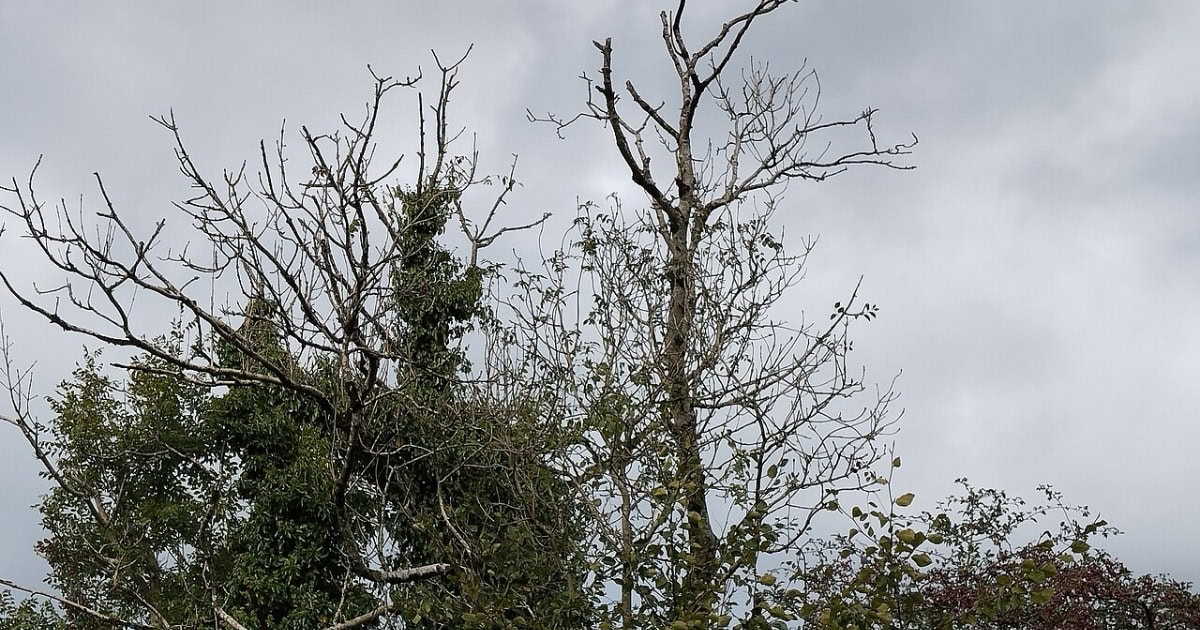Ash dieback pathogen genetics: why a tiny founder population mattered

Introduction
Ash dieback is caused by the fungus Hymenoscyphus fraxineus. Europe’s epidemic was seeded by just two haploid founders, then renewed each summer as spores are produced on last year’s leaf stalks. For tree owners, that explains the fast spread, uneven decline between trees, and why late-summer inspections matter. In the North West, wet summers, clay tracks and coastal exposure shape how we plan surveys and works. If you see classic signs over a road, play area or public right of way (PROW), book a survey. (McMullan et al., 2018; Forest Research, 2025). Nature Forest Research
Definition
Ash dieback is a disease of ash trees caused by Hymenoscyphus fraxineus. It blackens leaves, kills shoots, forms diamond-shaped stem lesions and can thin the crown from the top down. In Europe, the outbreak traces back to a tiny founder population—genetically, almost a coin flip—arriving from East Asia and meeting here. That origin still shapes today’s management choices. (McMullan et al., 2018; GOV.UK, 2025). Nature GOV.UK
From two founders to a national problem (ash dieback disease)
Here’s the genetics in plain English. The European population wasn’t a big, diverse wave. It was essentially two divergent haploid individuals that made it to Europe and then recombined. Each summer, the fungus completes a sexual stage on last year’s fallen ash rachises (leaf stalks) and releases clouds of spores from June to September. Small start, big consequences—because sexual reproduction reshuffles genes every year and keeps the epidemic going. (McMullan et al., 2018; Forest Research, 2025). Nature Forest Research
Why this matters to you:
- Spread and persistence. Once established locally, the pathogen “reboots” annually on leaf litter. That’s why we schedule inspections mid–late summer when symptoms are most visible. (Forest Research, 2025). Forest Research
- Uneven outcomes. Your neighbour’s ash might limp on while yours declines. That’s genetics—both of the fungus and the tree. Some ash show natural tolerance. (GOV.UK, 2025; Stocks et al., 2019). GOV.UK Nature
- Biosecurity still matters. Further introductions from the larger Asian gene pool could increase the pathogen’s adaptive options. (McMullan et al., 2018). Nature
Practical line: Set a July–September inspection cycle for ash on your land and stick to it. (Forest Research, 2025). Forest Research
Spotting genuine signs (and the ash dieback lookalike pitfalls)
(ash dieback symptoms • what does ash dieback look like • ash dieback pictures)
Leaves & shoots (best seen July–September).
Look for blackening and wilting of leaflets and soft shoots. Affected leaves often hang on among healthy ones. On young twigs, elongated brown lesions can form; shoots may shrivel. Two checks you can do now:
- Compare photos from the last two summers—widening thin patches in the crown are a red flag.
- At last year’s leaf nodes, look for diamond-shaped lesions under the bark (dark, slightly sunken). (Forest Research, 2025; RHS, 2025). Forest Research RHS
Bark, lesions & the crown.
As the disease bites, diamond lesions appear at branch junctions; peel back the bark and the tissue beneath is brown-grey. Crowns thin from the top down; epicormic shoots can burst lower on the stem as the tree struggles. (Forest Research, 2025; RHS, 2025). Forest Research RHS
Quick gallery cues (what to photograph).
- A mid-crown shot in August to show thinning.
- Close-ups of blackened leaves on green twigs.
- A branch union showing a diamond lesion.
- A careful cut revealing brownish-grey cambium beneath a lesion (if safe to do so). (Forest Research, 2025). Forest Research
Ash dieback lookalike: drought scorch, salt spray on coastal roads, and honey fungus can mimic stress. Timing (mid-late summer) and those node-based diamond lesions help separate true ash dieback from lookalikes—when in doubt, get a professional eye. (Forest Research, 2025). Forest Research
Practical line: If you see lesions over a path, road or PROW, book a survey.
What the latest science means for your trees
It isn’t all doom. Studies show some ash are naturally more tolerant, and real woodlands are now showing signs of polygenic adaptation—many small genetic changes adding up to better survival in younger cohorts. That supports keeping healthy, low-risk ash under watch rather than blanket removal. (Stocks et al., 2019; Metheringham et al., 2025). Nature Science
In 2025, researchers compared pre-epidemic adult trees with post-epidemic juveniles in a Surrey woodland and found a shift in genomic scores consistent with natural selection; modelling suggests a sizeable share of the most susceptible juveniles never made it to sampling age. Translation: nature is doing some sorting for us—but not fast enough to rely on luck alone. (Metheringham et al., 2025). Science
Ash dieback lookalike risk here is over-confidence: assuming a sturdy-looking tree is immune. Tolerance is not immunity, and structural defects still matter.
Practical line: If an ash is vigorous and low risk, consider retain & monitor with annual photos rather than rush to fell—document your decision. (GOV.UK, 2025). GOV.UK
North West realities: wet summers, clay, coastal exposure and roadside belts
In the North West, wet summers keep leaf litter moist—ideal for the fungus’s sexual stage—so we prefer inspections in late August/September when symptoms are distinct and access is still workable. Clay soils across parts of Lancashire, Merseyside, Cheshire and Greater Manchester mean soft verges and tracks; plan works to avoid rutting and use low-ground-pressure kit where possible. On the coast (Wirral, Formby, Fylde), salt-spray scorch can mimic disease; check for node-based lesions before calling it. Roadside belts along the A59/A6 corridors often mix ash with sycamore and beech; exposure alone can thin crowns, so photo-comparison year-on-year is your friend. (Forest Research on life cycle/timing, 2025). Forest Research
Grounded vignette (anonymised).
On a Preston access track after a wet August, we reviewed an ash line over a public right of way. Photos from 2023 vs 2024 showed a widening “see-through” upper crown in two stems, plus a clear diamond lesion at a low limb union. The adjacent trees were stable. We fenced, scheduled off-peak works, and kept the rest under watch.
Mini-case (Southport, coastal belt).
Blackened leaves and epicormic shoots triggered removal requests. Salt scorch and wind exposure had exaggerated stress in two stems with no node lesions; one stem showed an unmistakable diamond lesion. We chose selective prune + six-month re-inspection rather than strip-fell the group. Ash dieback lookalike caught early; unnecessary felling avoided.
Practical line: For roadside or PROW trees, photograph the same view annually and file images by date.
Your next steps (owners & managers)
Five simple steps
- Walk-through in late summer. Photograph mid-crown, close leaves, and branch unions. Label photos by date. (Forest Research, 2025). Forest Research
- Risk triage. Over paths, roads, play areas or benches? Put these at the top of the list.
- Check the legal bits. You’ll usually need a felling licence unless trees are dead or pose a real and immediate danger; TPOs and Conservation Area rules still apply—speak to your local authority or your arborist. (GOV.UK, 2025). GOV.UK
- Decide retain / prune / fell. Base it on risk, not panic. Tolerant, low-risk trees are valuable seed sources. (Stocks et al., 2019; GOV.UK, 2025). Nature GOV.UK
- Plan access and timing. Think clay tracks, traffic management, nesting birds, and safe handling of arisings. Grants exist for managing dangerous ash along roadsides and PROWs—worth checking. (GOV.UK, 2024/25). GOV.UK
Ash dieback lookalike reminder: if you’re coastal, always rule out salt scorch before you commission big works.
Practical line: If a declining ash overhangs a play area or road, book a survey now.
Pros & cons of common decisions
Retain & monitor
Pros: keeps amenity; preserves potential tolerance genes; lower immediate cost.
Cons: needs annual checks; risk can change quickly after storms.
Practical line: Agree a re-inspection date and keep a photo log.
Prune (risk-led)
Pros: targets deadwood/retrenchment; buys time; often cheaper than a fell.
Cons: may need repeat visits; traffic management on roadsides.
Practical line: Get a written scope (what cuts, what outcome) before work.
Fell & replace
Pros: removes high risk; clear slate for diverse replanting.
Cons: higher upfront cost; licences/TPOs; access damage possible on clay.
Practical line: If you do fell, replant a diverse mix suited to site and climate. (GOV.UK, 2025). GOV.UK
Clear next step (North West)
Based in Lancashire, Merseyside, Cheshire or Greater Manchester? We survey ash in gardens, farms, roadside belts and along PROWs. You’ll get a plain-English report, photographs, and clear next steps—retain, prune or fell—with legal notes where needed. Get in touch to book a visit this month.
FAQs (quick answers)
When should I check for ash dieback symptoms?
Mid–late summer (July–September) when wilting/blackening stands out and spores are active in the leaf litter stage. (Forest Research, 2025). Forest Research
Do I always need to fell infected ash?
No. Decisions are risk-led. Retain & monitor is often right for low-risk trees that remain vigorous. (GOV.UK, 2025). GOV.UK
What does a “diamond lesion” look like?
A dark, often sunken, diamond-shaped patch at a twig/branch junction; cutting back the bark reveals brown-grey tissue. (RHS, 2025). RHS
Could it be something else (an ash dieback lookalike)?
Yes—drought scorch, salt spray and honey fungus cause confusion. Timing and node-lesions help separate them. (Forest Research, 2025). Forest Research
Do I need a licence to fell?
Usually yes, unless trees are dead or pose a real and immediate danger; TPOs still apply. Check locally first. (GOV.UK, 2025). GOV.UK
Short disclaimer (England)
This article is general guidance for tree owners in England. Works to ash may require a Felling Licence; exemptions for dead or immediate danger trees are narrow, and TPO/Conservation Area rules still apply. Always check with your local planning authority and keep written evidence of risk. (GOV.UK, 2025). GOV.UK
References
- GOV.UK / Forestry Commission – Managing ash dieback in England (last updated 17 Jan 2025). Guidance on identification, legal duties, felling licences and TPOs. GOV.UK
- Forest Research – Ash dieback (Hymenoscyphus fraxineus). Life cycle, symptom timing, management stance (retain tolerant trees where safe). Forest Research
- **McMullan, M. et al. (2018),Nature Ecol. Evol. **– “The ash dieback invasion of Europe was founded by two genetically divergent individuals.” Two-founder origin; biosecurity implications. Nature
- **Stocks, J.J. et al. (2019),Nature Ecol. Evol. **– “Genomic basis of European ash tree resistance to ash dieback.” Resistance is polygenic; selection/breeding feasible. Nature PMC
- Metheringham, C.L. et al. (2025),Science – “Rapid polygenic adaptation in a wild population of ash trees under a novel fungal epidemic.” Evidence for microevolution toward tolerance in UK woodland. Science PubMed
- Tree Council – Ash dieback: a guide for tree owners (PDF). Owner-focused symptoms and steps. The Tree Council
- RHS – Ash dieback page. Homeowner symptom descriptors (black blotches; diamond-shaped lesions). RHS
GOV.UK – Grants for ash with ash dieback (roadsides & PROWs). GOV.UK
Book in your tree survey today
Get clear, professional advice from qualified tree surveyors you can trust. Whether you need a report for planning, insurance, mortgages or safety, we’ll deliver accurate results fast.


